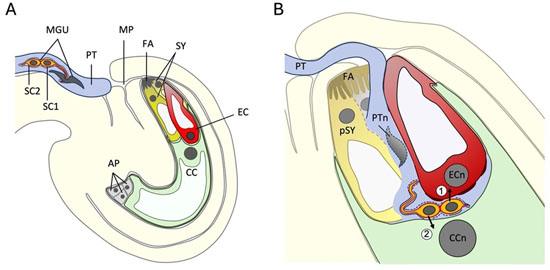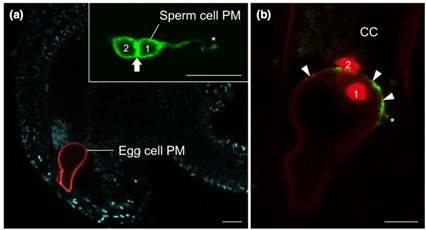Gamete interactions during double fertilization
Sexual reproduction in flowering plants involves double fertilization, a unique mechanism where two sperm cells, delivered by a single pollen tube, fertilize two female reproductive cells (egg and central cell). Within minutes after a sperm cell pair is released from a pollen tube into the embryo sac, each one of the sperm cells fuse with one of the female gametes. Due to the coordinated developmental progression and mutual dependency of the two fertilization products (embryo and endosperm), the success and timing of the two fusion events substantially affects seed set (Sprunck, 2020).

Despite the importance of double fertilization for seed development and thus for yield, our knowledge on female gamete specification and how the two gamete interaction and fusion events are accomplished is still limited. This is mainly due to the small size and the inaccessibility of flowering plant gametes, which challenged their isolation and utilization for transcriptomics and proteomics approaches (Sprunck, 2020).
Exploring our expression data derived from egg cells and central cells from wheat (Sprunck et al., 2005), we identified gamete-specific genes and their putative orthologs in Arabidopsis. The corresponding Arabidopsis promoter regions were used to generate a set of fluorescent marker lines for male and female reproductive cells. These marker lines now serve as important tools to investigate gamete interactions during double fertilization on the cellular and molecular level, including the analyses of fertilization-defect mutants that have been generated in our group.

One example is a cluster of egg cell-specific transcripts initially identified in wheat egg cells (EC-1) encoding secreted small cysteine-rich proteins (Sprunck et al., 2005). In the genome of Arabidopsis thaliana we identified five putative orthologous genes, termed EC1.1 to EC1.5. Fluorescent marker lines proved egg cell-specific activities of the EC1 promoters (Sprunck et al., 2012, Resentini et al., 2017). Functional studies using RNA interference and CRISPR/Cas9 showed that functional redundancy exists among these genes and that gamete fusion mostly fails in the absence of the EC1 proteins (Sprunck et al, 2012; Rademacher and Sprunck, 2013; Cyprys et al., 2019; Wang et al., 2022). Furthermore, EC1 proteins promote preferential fertilization of egg cells (Wang et al, 2024).
We are currently characterizing the detailed molecular mechanism of EC1 proteins during double fertilization.
